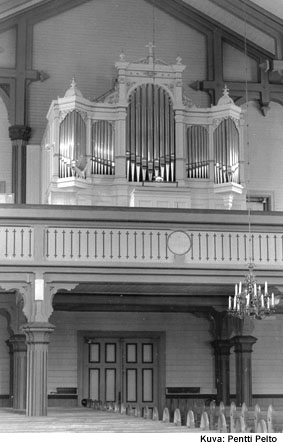|
HISTORICAL ORGANS IN FINLAND 
- Zachariassen, Jens Alexander 1899
- 20 stops, 2 manuals and pedal
- pneumatic action and pneumatic stop action
Hankasalmi Church was built between 1889 and 1892 to plans by Josef Stenbäck. It is a nave church with a steeple at its west end; it has transepts lower than the nave on both sides. The church is in the Neo-Gothic style, with a profusion of decorated detail.
Jens Alexander Zachariassen built the organ here in 1898. Jouko Pirkkanen renovated the instrument, which had remained unchanged, in 1998. The Hankasalmi organ is a valuable representative of the builder’s late work and significant not only for its historical value but for its sound qualities.
Appearance
The organ is located in the loft above the main entrance and structured following the in-line principle. The Manual I division is foremost; behind it is the maintenance access space, the Manual II swell box and the Pedal division. The bellows are housed in the steeple chamber.
The façade is divided into five sections. The middle one is the largest, an arched oblong flat topped with three crosses. The outermost sections are segmented towers; between these are intermediate flats of the same height as the towers. The mouths of the façade pipes form a diagonal line. Some of the pipes are speaking. The wood structure of the façade is fairly sturdy, and the decorations are rich and varied. It should be noted that the façade is identical with that of the Iisalmi organ. The names of both these instruments are written in the lower corner of Zachariassen’s drawing.
Technical features
The organ originally had four box bellows, but their number was increased to six, apparently during installation. All the boxes feed wind into a single wind trunk, so all divisions of the organ have the same wind pressure, slightly under 100 mm.
The chests are of the stop channel type typical for Zachariassen, and they are pneumatic. The chests for each division are divided into C and C sharp halves, and the pipes are placed alternately so that the largest pipes are in the middle. The pneumatic console is in front of the organ in the middle, and the organist sits with his back to the instrument. The keyboards have celluloid and ebony coverings, and the stop switches are white bipartite keys that look like the naturals; above them are porcelain plaques bearing the stop names. A stop is activated by pressing the forward part of the key and deactivated by pressing the rear part. The small white knobs of the free combination are above the stop plaques.
The pneumatic action transfers the organist’s movements to the chest through lead pipes. The relays are fixed to the side of the chest, not removable as became the practice slightly later.
The manner of manufacturing the pipes is decidedly different from Zachariassen’s earlier practice. The pipes were evidently not made in Uusikaupunki. There are also differences in the voicing compared with the builder’s earlier instruments. The active and brilliant sound of Zachariassen’s organs of the 1870s and 1880s has here been replaced with soft, singing and blending qualities. The dynamic principle, with gradual changes, seems to have become dominant in this instrument.
Musical properties
The touch is pneumatically soft and remains unchanged even when couplings are used. The action has minimal allowance for adjustment for changes in climate. This was an acceptable practice in the late 19th century, since churches were usually not heated.
The main division is the cornerstone of the sound of the instrument. It contains three Principals and a small but significantly loud compound stop. The 8’ flutes and violin provide scope for solos and accompaniments. The Bordun 16’ and Trompet 8’ round out the disposition. Manual II is a quiet accompaniment division which includes many 8’ stops. Even without using the swell box, it offers a wide dynamic range.
Disposition
Manual I C-f3 | Manual II C-f3 | Pedal C-d1 |
Bordun 16’ | Geig.principal ’8f | Violon 16’ |
Principal 8’ | Konsertflöte 8’ | Subbass 16’ |
Flauto major 8’ | Liebl.gedackt 8’ | Principal 8’ |
Gamba 8’ | Salicional 8’ | Oktav 4’ |
Rörflöte 8’ | Aeoline 8’ | Bassun 16’ |
Oktav 4’ | Flauto traverso 4’ | |
Oktav 2’ | | |
Mixtur 2-3kör 2 2/3’ | | |
Trompet 8’ | | |
| | |
| | |
| | |
| | |
|
|
|
II-I, I-Ped, II-Ped, I 4’ | | |
mezzoforte, forte fortissimo | | |
One free combination | | |
| | |
| | |
| | |
| | |
| | |
| | |
| | |
| | |
| | |
| | |
Further information
Pentti Pelto, Kaksi suomalaista urkuperinnettä (dissertation), Sibelius Academy, Vammala 1994
|